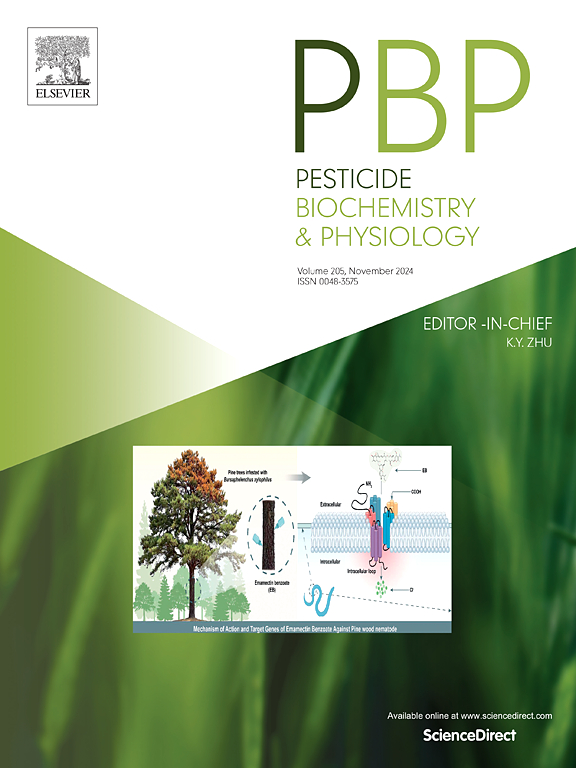Odorant receptor 75 is essential for attractive response to plant volatile p-anisaldehyde in Western flower thrips
IF 4.2
1区 农林科学
Q2 BIOCHEMISTRY & MOLECULAR BIOLOGY
引用次数: 0
Abstract
The Western flower thrip (WFT), Frankliniella occidentalis, is a major pest of many vegetable crops and also a vector for the tomato spotted wilt virus, causing devastating damage worldwide. Odorant receptors (ORs) play an important role in host plant searching, however, specific functions of those ORs in WFT remain unclear. In this study, the attractive activity of four plant volatiles ((S)-(−)-verbenone, p-anisaldehyde, methyl isonicotinate, and benzaldehyde) to WFT was confirmed using a Y-tube olfactometer. Then, the specific receptor, OR75, was screened out as the candidate OR for these odorants, as its expression was significantly upregulated upon exposure to these odorants. Further in vitro functional assays with Xenopus oocyte expression system confirmed sensitivity of OR75 to p-anisaldehyde and three other odorants (β-ionone, undecanal and cinnamaldehyde). Of the three odorants, β-ionone was also attractive to WFT. Further, in vivo RNA interference experiments showed that the dsOR75 treated thrips lost their attractive response to p-anisaldehyde, but retained response to β-ionone. Finally, 3-D structures prediction and molecular docking showed that OR75 formed a hydrogen bond with p-anisaldehyde at His150 residue, while no hydrogen bond formed with β-ionone, undecanal or cinnamaldehyde. Taken together, OR75 plays a crucial role in perception of p-anisaldehyde, which helps us understand the host-seeking mechanisms of WFT, and provides a basis for development of olfactory based pest control strategies. This is the first report of an OR playing roles in sensing p-anisaldehyde in thrips.

气味受体75是蓟马对植物挥发性茴香醛产生吸引反应所必需的
西部花蓟马(Frankliniella occidentalis)是许多蔬菜作物的主要害虫,也是番茄斑点枯萎病毒的载体,在世界范围内造成毁灭性的破坏。气味受体(Odorant receptors, ORs)在寄主植物寻找中起着重要作用,但其在WFT中的具体功能尚不清楚。在本研究中,用y管嗅觉仪确定了四种植物挥发物((S)-(−)-马鞭草酮、对茴香醛、异烟酸甲酯和苯甲醛)对WFT的吸引活性。然后,特异性受体OR75被筛选出来作为这些气味剂的候选OR,因为它的表达在暴露于这些气味剂后显着上调。此外,利用爪蟾卵母细胞表达系统进行的体外功能实验证实了OR75对茴香醛和其他三种气味剂(β-离子酮、十一醛和肉桂醛)的敏感性。在三种气味剂中,β-ionone对WFT也有吸引力。此外,体内RNA干扰实验表明,dsOR75处理的蓟马失去了对茴香醛的吸引反应,但保留了对β-离子酮的反应。最后,三维结构预测和分子对接表明,OR75在His150残基上与对茴香醛形成氢键,而与β-离子酮、非醛和肉桂醛没有形成氢键。综上所述,OR75在对茴香醛的感知中起着至关重要的作用,这有助于我们了解WFT的寻宿主机制,并为开发基于嗅觉的害虫防治策略提供基础。这是第一次报道OR在蓟马对茴香醛的感知中起作用。
本文章由计算机程序翻译,如有差异,请以英文原文为准。
求助全文
约1分钟内获得全文
求助全文
来源期刊
CiteScore
7.00
自引率
8.50%
发文量
238
审稿时长
4.2 months
期刊介绍:
Pesticide Biochemistry and Physiology publishes original scientific articles pertaining to the mode of action of plant protection agents such as insecticides, fungicides, herbicides, and similar compounds, including nonlethal pest control agents, biosynthesis of pheromones, hormones, and plant resistance agents. Manuscripts may include a biochemical, physiological, or molecular study for an understanding of comparative toxicology or selective toxicity of both target and nontarget organisms. Particular interest will be given to studies on the molecular biology of pest control, toxicology, and pesticide resistance.
Research Areas Emphasized Include the Biochemistry and Physiology of:
• Comparative toxicity
• Mode of action
• Pathophysiology
• Plant growth regulators
• Resistance
• Other effects of pesticides on both parasites and hosts.

 求助内容:
求助内容: 应助结果提醒方式:
应助结果提醒方式:


